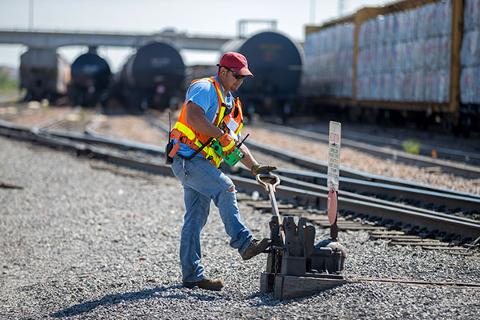News Releases
Safety
Union Pacific Improves Community Safety through Training, Technology and Investments
Railroad Achieves 7 Percent Derailment Decrease
Omaha, Neb., February 9, 2015
Training, technology and investments helped Union Pacific improve safety in 2014 by reducing its reportable derailment rate 7 percent. The company improved its reportable derailment rate to 3.0 from 3.24 in 2013, and has improved this rate 38 percent over the past 10 years.
A company's derailment rate is calculated using the number of derailments per million train miles reportable to the Federal Railroad Administration.
"Nothing is more important than the safety of our employees and communities," said Bob Grimaila, Union Pacific vice president - Safety, Security and Environment. "We invested $4.1 billion in 2014 in our network and operations, enhanced already solid track inspection processes and technology, and broadly deployed creative employee training initiatives to continue our journey to zero derailments."
Innovative employee training made a direct impact on decreasing derailments and enhancing overall safety. The company deployed illustrative training videos on internal television systems, in training classes and on the employee intranet. These videos focused on shoving moves, where employees observe and "protect" an in-motion rail car as it is sorted and moved into a new train lineup. These shoves determine a rail car's destination and often involve using switches that must be properly aligned to avoid a derailment.
Union Pacific invested more than $31 billion over the past 10 years to strengthen its infrastructure, technology and equipment, decreasing derailments 38 percent over the same period. The railroad's prevention and risk reduction process includes a variety of initiatives:
- Using lasers and ultrasound technology to identify rail defects;
- Forecasting potential failures before they happen by tracking the acoustic vibration on wheels and heat trends on wheel bearings;
- Performing a real-time analysis of every rail car each time it passes a trackside sensor, equaling 20 million car evaluations per day; and
- Regular employee participation in rigorous safety training, including training to identify and prevent potential derailments.
About Union Pacific
Union Pacific Railroad is the principal operating company of Union Pacific Corporation (NYSE: UNP). One of America's most recognized companies, Union Pacific Railroad connects 23 states in the western two-thirds of the country by rail, providing a critical link in the global supply chain. From 2005-2014, Union Pacific invested more than $31 billion in its network and operations to support America's transportation infrastructure. The railroad's diversified business mix includes Agricultural Products, Automotive, Chemicals, Coal, Industrial Products and Intermodal. Union Pacific serves many of the fastest-growing U.S. population centers, operates from all major West Coast and Gulf Coast ports to eastern gateways, connects with Canada's rail systems and is the only railroad serving all six major Mexico gateways. Union Pacific provides value to its roughly 10,000 customers by delivering products in a safe, reliable, fuel-efficient and environmentally responsible manner.
The statements and information contained in the news releases provided by Union Pacific speak only as of the date issued. Such information by its nature may become outdated, and investors should not assume that the statements and information contained in Union Pacific's news releases remain current after the date issued. Union Pacific makes no commitment, and disclaims any duty, to update any of this information.
Resources

A Union Pacific employee in Big Spring, Texas, properly lines a switch to determine the rail car's destination.
Media Contact
Calli Hite
402-544-3026
